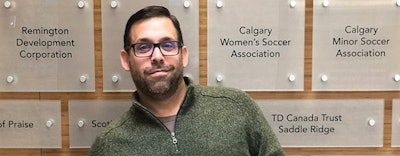
Having been in collegiate recreation and community development for more than 20 years in multiple leadership capacities, I have experienced and created measurable change in adult recreation behavior by intentionally focusing on fostering a sense of belonging.
At the University of Waterloo, we increased recreation program participation from 11,000 to more than 30,000 participants in less than five years with no substantial change to population of the school or the addition of new facilities. This was accomplished through focusing on intentional programs, services and engagement strategies that prioritized fostering a sense of belonging over everything else. Not only did this result in higher participation numbers, but also sustainable revenue streams, better utilization of resources, stronger support for collegiate recreation's value on campus, and increased student connection to the institution.
Belonging defined
What does it mean to belong? If inclusion is the practice, diversity is the framework and equity is the goal, belonging is the feeling people have when the prior three are realized. The power of belonging, where individuals feel invited, welcomed and included, is owned by the participant, and it is our role as recreation providers to help foster that power.
The "invitation" is the written or spoken request to come somewhere or do something. It is how the participant knows about what you are offering and the understanding (whether right or wrong) they have of the culture, behaviors and outcomes before participating. Examples include marketing — publications, advertisements, branding, social media — word of mouth, and any preconceived notions the participants may have about your organization, as well as the cost and convenience of its programs of interest.
The "welcome" is the way in which someone is met and spoken to when they arrive at your facility or show up for your program. It is the culture, behaviors and understanding a participant experiences and/or observes. Often this starts and stops at the customer service desk but also includes program instructors, wayfinding, accessibility, music and imagery, space making, staff diversity, and participant demographics.
Being "included" means that everyone can use the same facilities, take part in the same activities and enjoy the same experiences in a way that is meaningful and enjoyable to them. Essentially, the programs, services and experiences match the participants' needs of appropriate skill level, competitiveness and social connectivity.
Imagine you are invited to a party. You're free, and you've heard a lot of buzz about it from friends. There will be music and activities that you love, and your best friend says they will pick you up. When you arrive, you are greeted at the door by the host, given a small tour, told where the food and drinks are, given some general rules and introduced to some people. The space is warm, with lots of room to move, and the DJ is playing your jam. You are having great conversation, some friends ask you to dance and you play some party games. This is a good party.
Bigger, better parties
Recreation is putting on great parties with music, guests and activities that are geared solely for those participants comfortable with the current recreation culture. Sense of belonging is limited to a select group of those ingrained in the culture, which leads to severe groupthink — we engage, market to and program to those already heavily involved. The problem is, if we want to make a big shift in the health of our society, we need to break that groupthink and start engaging those not already participating. Recreation cannot continue to throw the same parties and wonder why they aren't attracting more diverse participants.
The typical invitation in recreation relies heavily on membership blitzes that tout health benefits along with new trends that have traditionally not done well in recruiting and retaining new participants. We even try to scare adults into participating — get off the couch or you are going to die! The sales pitch might get me into the facility, but if I don't feel like I belong, I will not be there very long. Recreation has essentially become a revolving door, where previously recruited participants leave for the new ones coming in. Our efforts have proven unsustainable for growth.
We assume that participants coming to our facilities feel welcome and included because we put up advertisements, offer activities that we think people want and provide space to play. The fault lies in the current culture that puts the ownership on participants to navigate the challenging landscape of sport and recreation. There is little to no intentional effort to create a sense of belonging outside of general customer service. We hope that the participants will do it themselves.
Here is how we can help people feel like they belong in recreation. Begin by focusing on the people and not the space:
• Use metrics of success that include participants' sense of belonging.
Instead of head count and program feedback, start measuring the impact that programs and staff had on helping participants feel like they belong. Measure and celebrate unique participation. Would you rather have five participants each in a program, or one participant utilizing five programs?
• Intentionally provide resources that help participants navigate the rec landscape.
Schedule staff members or volunteers to facilitate users in drop-in spaces. Have regular check-ins with members, asking them how they are fitting in and what help they may need.
• Provide training to staff that prioritizes creating a welcoming environment.
We value certifications, technical skills and experience from our instructors, yet most participants will gravitate and give positive feedback because they like how the instructor made them feel — both physically and socially.
• Invitation is more than just marketing.
Membership blitzes may get them through the door, but it won't keep them. Nothing is more powerful than word-of-mouth advertising, and your current participants should be valuable resources to help spread that invitation to their friends. No amount of emails, posters or incentives could make me play golf, but the invitation from a trusted friend will have me yelling "fore!"
• Welcoming is more than a smile.
What participants see or don't see in your facility is just as important in terms of them feeling welcome. Are your spaces accessible? Do the sounds and imagery make participants feel comfortable? Do they see themselves reflected in the staff, programs and other participants?
When people feel like they belong — that is, they feel invited, welcomed and included — we will begin to see more people getting more active more often. When recreation organizations put more resources into fostering a sense of belonging among participants, as well as into systems, facilities and infrastructure, we will begin to see a revolution of a healthier and more active society.
This article originally appeared in the April 2020 issue of Athletic Business with the title "Fitting In: The importance of belonging to recreation." Athletic Business is a free magazine for professionals in the athletic, fitness and recreation industry. Click here to subscribe.




































